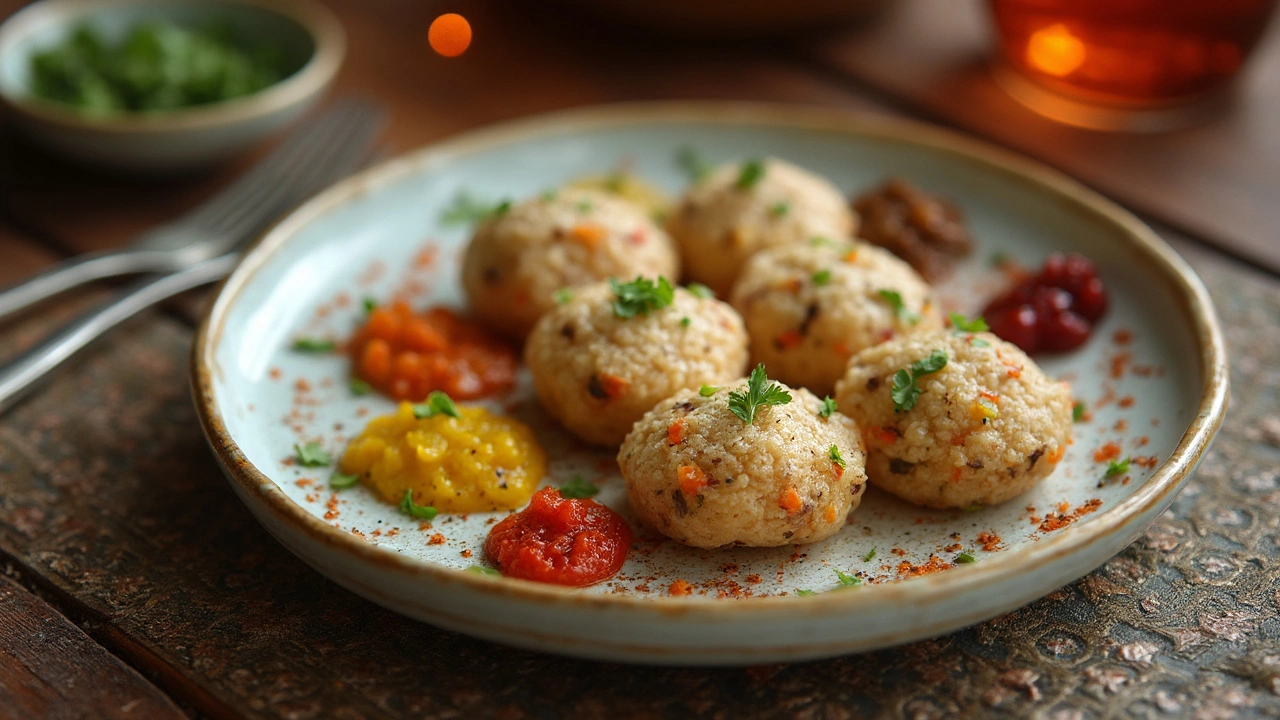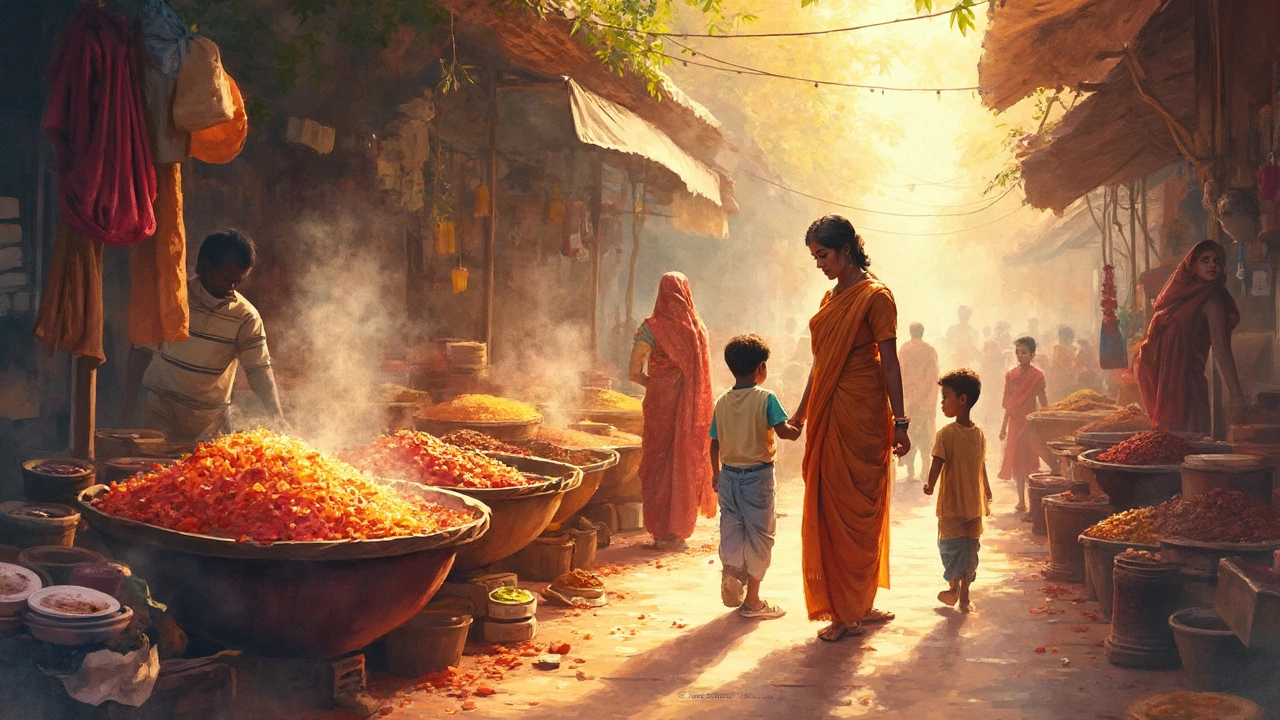Have you ever woken up with a craving for something light yet satisfying? That's where India's beloved breakfast superstar, idli, steps into the spotlight. Originating from South India, these little white rice cakes have made their way into breakfast tables all over the country, and for good reason.
Idli is cooked using a fermented batter of rice and urad dal (black gram lentils). Don't let the word 'fermented' scare you off—it's what makes idli light, fluffy, and oh-so-digestible. Steaming is the magic behind their pillowy texture, and it only takes about 15 minutes once you have the batter ready.
But it’s not just about plain idlis anymore! From rava idli to stuffed versions with spicy fillings, there’s an idli for every taste bud. Pair them up with coconut chutney, tangy tomato chutney, or the classic sambar, and you've got a breakfast that is simply irresistible.
Aside from being delicious, idlis bring an exciting punch of nutrients to your morning meal. Rich in proteins and vitamins, they're a great way to kickstart your day. Plus, for anyone keeping an eye on their health, they’re typically low in calories.
The Origin of Idli
Ever wondered how the humble idli came to be such a star on the Indian breakfast table? It’s a story that goes way back, possibly to ancient Tamil Nadu, where rice was a staple food. Some food historians suggest that the concept of steaming rice-based dishes might have been influenced by a technique that came from Indonesia, but the exact origins remain a bit of a mystery. What’s clear is, by the 10th century, references to idli were being made in South Indian texts.
During the time of the Chola dynasty, South Indian culture and cuisine spread across various parts of Southeast Asia. It is believed that during this period, some of the foundational techniques for making idlis could have intertwined with those cultures. However, in its current form, the idli as we know it, made from a fermented mix of rice and urad dal, probably developed much later.
There are many reasons why idli has stood the test of time. First up, they're ridiculously easy to prepare and digest. Plus, their simple ingredients like rice and lentils have always been plentiful in Southern India. Fast forward to 2025, and you'll find idli joints and street vendors selling these beloved rice cakes across India, often accompanied by a variety of delectable chutneys and sambar.
Despite its plain appearance, the idli is more than just a meal; it’s a testament to India's incredible culinary heritage. Whether steamed in a modern kitchen or over open flames in rustic setups, idlis maintain their unique flavor and appeal.
Making Idli at Home
If you're craving a fresh, homemade Indian breakfast, making idli at home is easier than you might think. Let’s break it down step-by-step so you can enjoy these fluffy delights right in your kitchen.
First things first, you'll need the main ingredients: rice and urad dal (black gram lentils). The usual ratio is 2:1, but feel free to tweak it a little until you find what you like best. Here's how you can make it happen:
- Soaking: Wash and soak 2 cups of rice and 1 cup of urad dal separately for at least 4-6 hours. Some folks add a teaspoon of fenugreek seeds to the dal—this can enhance the fermentation and add flavor.
- Grinding: Once soaked, grind the urad dal into a smooth, fluffy batter. Then, grind the rice to a slightly coarse batter. Combine the two in a big bowl.
- Fermentation: The magic part! Let the batter sit in a warm spot overnight or for about 8-12 hours. It should rise and be bubbly; that’s when you know you’re done!
- Steaming: Grease your idli molds. Gently stir the batter and spoon it into the molds. Steam them for about 10-12 minutes. If you poke it with a toothpick and it comes out clean, they’re ready.
Once your idlis are ready, you can serve them with a variety of chutneys or sambar. The whole process becomes pretty quick once you've got the hang of it, and trust me, it's so worth the wait.
For those who are short on time, using rava idli mix is a great alternative. It skips the soaking and fermentation steps, which is handy for a speedy quick breakfast india option.
Remember, practice makes perfect. If your first batch isn’t spot-on, don’t worry—just keep at it! Each home-cooked idli adds a bit more warmth and love to your table.

Nutritional Benefits
Ever wonder what makes idli a powerhouse breakfast option? Turns out, it's not just the taste that makes these little cakes a hit. When it comes to nutrition, idli is definitely a star player.
First off, idlis are made primarily from rice and urad dal, so they are naturally gluten-free. Great news for everyone who's sensitive to gluten! But that's not all. The fermentation process used in preparing the batter boosts the bioavailability of nutrients. This means your body can absorb more of those good vitamins and minerals.
You’re looking at a good dose of protein thanks to the urad dal. Plus, they’re rich in complex carbs, keeping you full and energized for longer—perfect for tackling that morning rush. Not to mention, idlis are pretty low in calories compared to most breakfast items, making them a smart choice if you’re watching your calorie intake.
| Nutrient | Amount (per 100g) |
|---|---|
| Calories | 58 kcal |
| Protein | 2.5 g |
| Carbohydrates | 12.5 g |
| Fiber | 0.6 g |
Another bonus? The fermentation process also increases the availability of B-vitamins, which are essential for energy production and maintaining a healthy nervous system. So you’re not just filling your stomach; you’re actually fueling your body right!
With all this going for it, it’s no wonder idli is celebrated far beyond its origins in South India. Next time you’re on the hunt for a wholesome breakfast, remember what a nutritional treasure this quick breakfast India option truly is.
Idli Variations
Idli may start out as a simple, traditional rice cake, but folks all over India have jazzed it up in some pretty exciting ways. If you're in the mood to try something different, or just want to impress someone with your culinary creativity, exploring idli variations is the way to go.
Let’s first talk about the rava idli. It’s made with semolina instead of rice, and what’s cool is how it’s often flavored with spices like mustard seeds and curry leaves. Perfect if you're on the clock since it doesn’t require fermentation. Plus, it’s fluffy and pairs really well with coconut chutney.
Next up, we’ve got stuffed idli. Think of it like a surprise inside your rice cake, where spicy potato mixtures or even cheese make an appearance. It's like South India meets your favorite street snack.
For those with a sweet tooth, there's the delightful dessert twist. Sweet idlis use jaggery, coconut, and sometimes even cardamom to take these cakes into dessert territory. Yum, right?
Idlis aren’t just about what's inside them. The toppings and dips can totally transform them too. Think idli Manchurian, where they’re tossed in a tangy, spicy sauce, giving your simple breakfast a kick of Indo-Chinese flair.
- Kanchipuram Idli: Famous in Tamil Nadu, they're seasoned with ginger, cumin, and pepper, offering a beautifully fragrant taste.
- Mini Idlis: Great for kids or if you love bite-sized treats, these adorable tiny versions are often drizzled with ghee or chutney.
- Muday Idli: Known for being a healthy option, they're made with millet, providing a nutritious twist on a classic.
If you're still curious, check out this fun fact: According to a culinary survey in 2024, idli ranked as the second most popular breakfast dish in India, right after poha! This just shows how these variations keep folks excited and coming back for more.
The possibilities are endless when it comes to these delicious steamed beauties. So, next time you're experimenting in the kitchen, why not try a new idli variation?

Serving Suggestions
So you have your idlis ready, and now you're wondering how to serve them up for the best breakfast experience. Well, these fluffy wonders shine when paired with the right accompaniments. Here's how you can elevate your Indian breakfast game with the perfect serving suggestions.
Chutneys Galore: Chutneys are the go-to sidekick for idlis. A traditional coconut chutney is a creamy, nutty delight, while a spicy tomato chutney can add a zingy kick. If you like a bit of sweetness with your breakfast, try a peanut chutney or something with a hint of jaggery.
Sambar Love: No discussion on idlis is complete without mentioning sambar. This lentil-based vegetable stew, softly spiced and aromatic, complements idlis perfectly. It’s a hearty accompaniment that’s packed with proteins and veggies.
- Tomato Sambar - Light and tangy with a tomato base.
- Mixed Vegetable Sambar - A nutrient powerhouse with potatoes, carrots, and beans.
Modern Twists: Looking to surprise your taste buds? Try serving idlis with a vibrant beetroot chutney or a refreshing mint-cilantro mix. Want to go fusion? Pair them with a dip of Greek yogurt and a sprinkle of chili flakes.
If you're serving idli to a big crowd, why not lay out a platter with all these options and let everyone pick their favorite? Whether you're a fan of the classic combos or (like me) can't resist trying something new every time, serving suggestions elevate the whole experience, making a humble breakfast feel like a feast!
